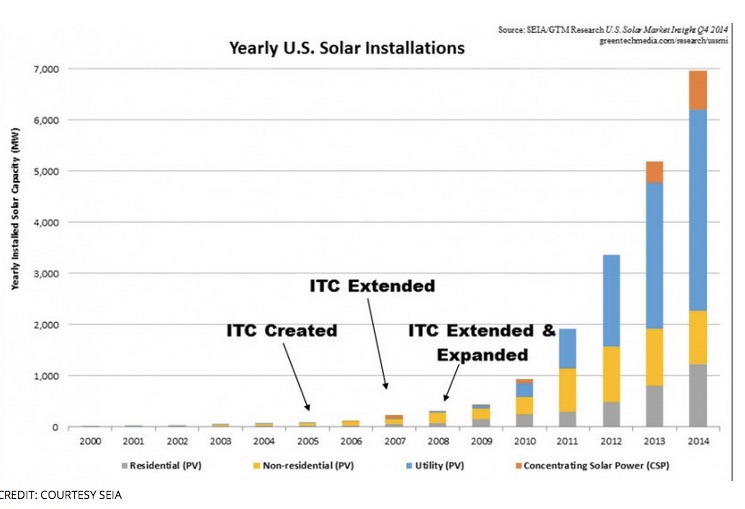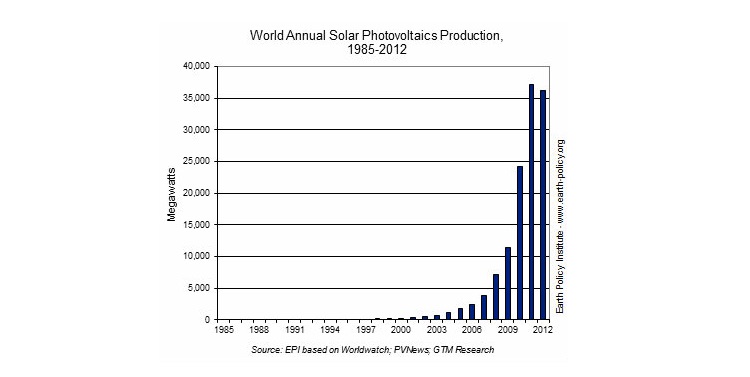Bill Gates, Microsoft founder and the richest man in the world, plans to double his billion-dollar investments in green technology in an effort to stave off catastrophic climate change, he told The Financial Times.
“Climate change is a big problem, but it’s one that if you do the right types of [research and development] you can actually avoid the ill effects,” Gates said.
Gates wants to expand his investment in alternatives to fossil fuels — and he wants alternatives even to our current renewable options. He said he thinks new technology is the only way to get truly low-cost clean energy, FT reported.
It’s true, renewable energy is often criticized for being too expensive (even though in many places, solar and wind are cost-competitive with traditional fossil fuel sources). But experts on solar — the fastest growing source of renewable energy — say what pushes costs down is not a “breakthrough” technology. It might not sound exciting, but it’s changes in policy and financial innovations that spur industry growth and could be the difference between transforming the energy grid soon, or too late.
Luckily, we already have scalable, workable technology for renewable energy. Expanding and improving those will get us further, faster than the “miracle” Gates called for.
The Future Is Now, Not Later
Most scientists agree that if we do not curb carbon emissions dramatically, there will be irreversible, catastrophic climate change by 2036. Note 1. But it takes about 30 years for a new technology to enter the energy space, solar expert Jigar Shah told ThinkProgress.
That’s because unlike consumer technology, such as a phone or personal computer, electricity is a giant system. Shah likens adding new electricity sources to rolling out a new kind of asphalt that would make roads last three times as long. The product is undoubtedly better, but how long would it take for all governments and companies around the world to switch over? Furthermore, electricity — more so than asphalt — needs to be reliable, so it has a high barrier to the market.
People like Gates “are so used to consumer tech that they don’t understand how infrastructure works,” Shah said.
“The only way to solve climate change is a trillion dollars at a time,” Shah said, referencing the huge costs of transitioning to clean energy. “And if you’re going to bring a trillion dollars of capital [into a technology], think about how much testing you demand.”
Meanwhile, Gates has invested in nuclear recycling and solar chemical power — technologies that are just now being developed.
Solar photovoltaic technology has been around for about four decades, and wind power has been in use for more than a century, so maybe it’s not surprising that in the first three months of this year, solar and wind accounted for 70 percent of the United States’ new energy generating capacity. Note 2. Maybe it’s surprising that it took this long.
How Renewable Energy Gets Big
No matter how effective a technology is, it will only take off under certain conditions. Policy and financing might not sound sexy, but they work — they are what’s needed for renewable energy to proliferate worldwide.
For instance, a 2004 policy in Germany is widely credited with lowering solar panel prices worldwide. The feed-in tariff — under which renewable energy producers are compensated for the electricity they put on the grid, cost-adjusted by how expensive the source is. It was a national policy, and industry could depend on it. These types of pro-renewable, dependable policies can really make things happen. Note 3.
“The national feed-in tariff in Germany was really the tipping point that allowed the solar industry globally to drive costs down,” the Department of Energy’s Minh Le told ThinkProgress.
This graph shows the growth in solar panel production.
It’s also worth noting that fossil fuel industries enjoy a literal wealth of subsidies. Note 4. The IMF calculated the public cost of fossil fuels at $5.3 trilion, when health and environmental impacts are considered. Note 5.
Gates is pushing for technological investments, not policy ones, and he thinks the government should be focusing on the same thing. “Government [research and development] budgets should be increased in order to accelerate innovation,” he said in the interview last week.
In fact, the current administration is doing quite a bit to foster innovation — both technical as well as financial. The Department of Energy’s SunShot incubator program, for instance, has provided $120 million to 120 small businesses since 2007. Those businesses have turned around and leveraged their successes for another $2 billion in private sector investments, according to Le. “It’s a great example of the government making a little investment and private sector taking it on,” he said.
But look at what happened when the United States implemented a tax credit on solar investments in 2006.
 Installations went way up, and costs came way down. In fact, the average cost of solar has fallen by 73 percent since the tax credit was enacted. Note 6.
Installations went way up, and costs came way down. In fact, the average cost of solar has fallen by 73 percent since the tax credit was enacted. Note 6.
A similar thing happened with the wind industry, when a tax credit was introduced for that technology. (When the credit expired, the wind industry laid off an estimated 30,000 people layoffs. Policy certainty matters.) Note 7.
The Silver Lining
That’s not to say there is nothing good in Gates’ comments. Gates is an outstanding philanthropist. He is worth about $80 billion, personally, and co-chairs the $42.9-billion Gates Foundation with his wife, Melinda. Note 8. The foundation has done an extraordinary amount of good around the world, particularly in developing nations.
But for years, climate activists have been urging Gates to do more on climate mitigation. British newspaper The Guardian launched a campaign in March urging Gates to divest from coal and fossil fuels. Note 9.
According to a recent study, 92 percent of U.S. coal, most of Canada’s tar sands, and all of the Arctic’s oil and gas will have to stay in the ground in order to limit the increase in worldwide temperatures to 2°C. Note 10. The University College London researchers found that “a third of oil reserves, half of gas reserves, and over 80 percent of current coal reserves should remain unused from 2010 to 2050.”
In order to achieve that goal — and ultimately avoid the catastrophic effects associated with a 2°C warming — we need to seriously curb the use of fossil fuels.
But even though Gates hasn’t done that, it’s still meaningful that the world’s richest man is talking about the need to address climate change.
“I would not say that Bill Gates is off mark,” DoE’s Le said. “I would say that he’s focusing his dollars on an important part of the solution space.”
Note 1. Michael Mann, “Earth Will Cross the Climate Danger Threshold by 2036,” Scientific American (1 April 2014). www.scientificamerican.com/article/earth-will-cross-the-climate-danger-threshold-by-2036/
Note 2. US Federal Energy Regulatory Commission, Office of Energy Projects Energy Infrastructure Update (March 2015). www.ferc.gov/legal/staff-reports/2015/mar-infrastructure.pdf
Note 3. Zachary Shahan, “German Solar Feed-in Tariffs Wildly Successful (New SEIA Report),” Clean Technica (7 August 2014). cleantechnica.com/2014/08/07/germany-solar-feed-in-tariffs-seia/
Note 4. Emily Atkin, “Fossil Fuels Receive $500 Billion A Year In Government Subsidies Worldwide,” Think Progress 7 Nov 2013). thinkprogress.org/climate/2013/11/07/2908361/rich-countries-fossil-fuel-subsidies/
Note 5. Samantha Page, “Report: Fossil Fuels Receive $5.3 Trillion A Year In Subsidies Worldwide,” Think Progress 22 May 2015). thinkprogress.org/climate/2015/05/22/3662148/we-pay-what-for-fossil-fuels/
Note 6. Solar Energy Industries Association, Solar Industry Data: Solar Industry Breaks 20 GW Barrier – Grows 34% Over 2013. www.seia.org/research-resources/solar-industry-data
Note 7. Simone Sebastian, “Potential loss of tax credit becalms wind industry,” Chron (10 July 2012). www.chron.com/business/energy/article/Potential-loss-of-tax-credit-becalms-wind-industry-3697651.php
Note 8. Bill & Melinda Gates Foundation, Financials www.gatesfoundation.org/Who-We-Are/General-Information/Financials
Note 9. Emma Howard, “Bill Gates to invest $2bn in breakthrough renewable energy projects,” The Guardian (29 June 2015). www.theguardian.com/environment/2015/jun/26/gates-to-invest-2bn-in-breakthrough-renewable-energy-projects?CID=CCG_TTccgEN_D_EXT
Note 10. Tom Kenworthy, “Majority Of U.S. Coal, Canadian Tar Sands Will Have To Stay In The Ground To Meet Climate Goals,” Think Progress (8 Jan 2015). thinkprogress.org/climate/2015/01/08/3609408/coal-tar-sands-stay-in-the-ground-to-avoid-catastrophe/
Originally published in Climate Progress (30 June 2015). thinkprogress.org/climate/2015/06/30/3675684/renewable-energy-needs-policy-not-tech-innovations/



No comments yet, add your own below